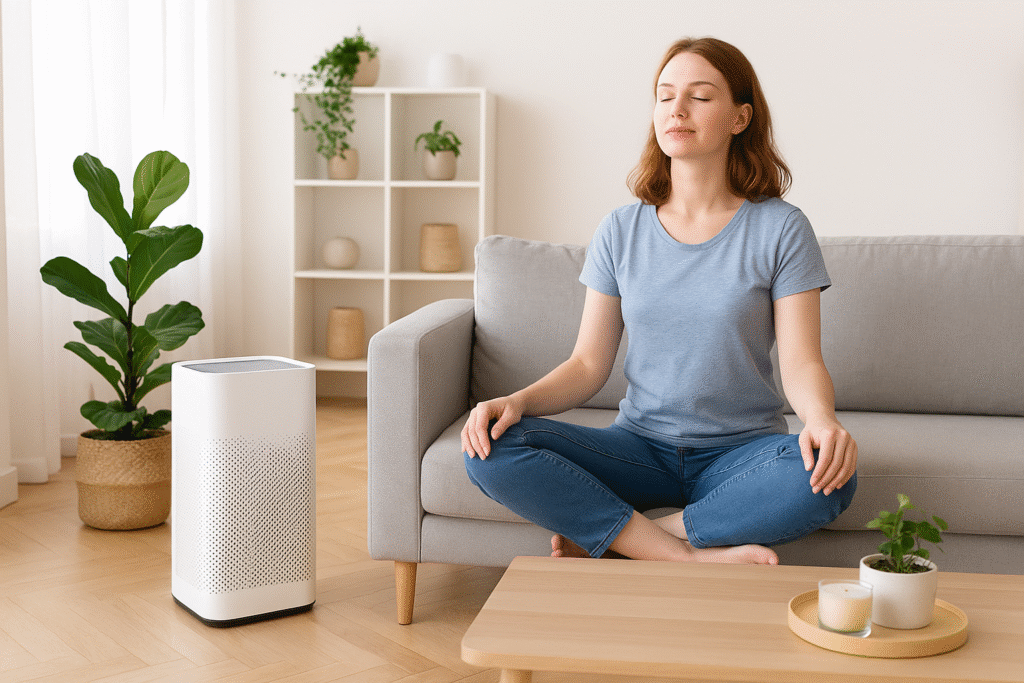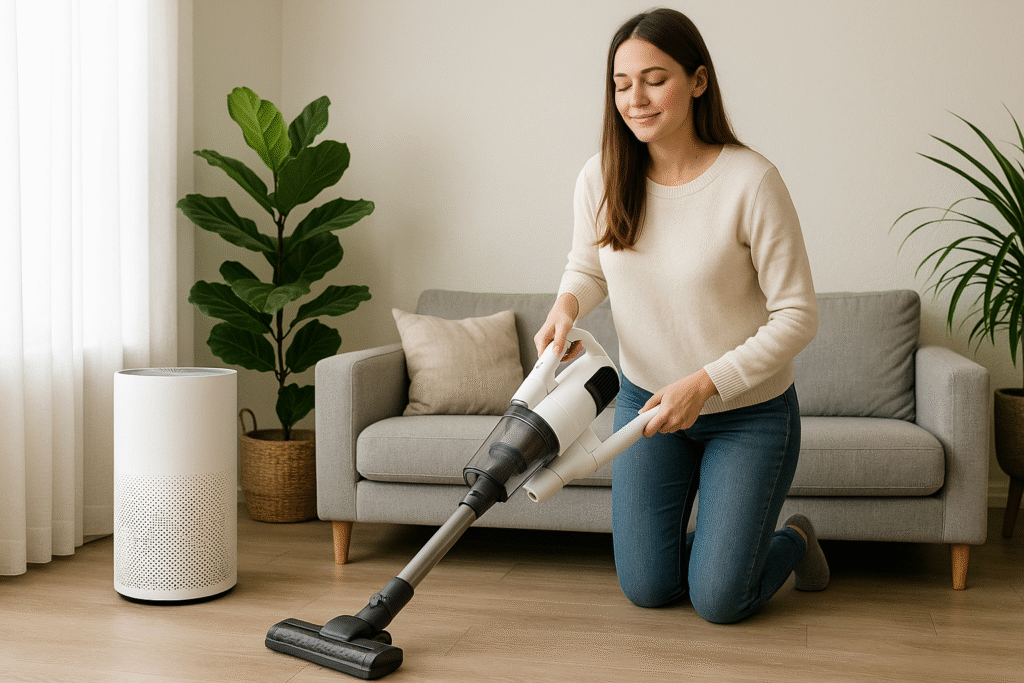We spend roughly 90% of our time indoors—so the air inside your home matters. Invisible pollutants like fine particles (PM2.5), volatile organic compounds (VOCs), carbon dioxide, mold spores and gas leaks quietly affect sleep, allergies, lung and heart health, and even cognitive performance. The good news: many effective, low-cost Indoor Air Pollution Solutions are simple DIYs or inexpensive upgrades, not expensive overhauls.
This practical, evidence-based guide (US, UK & global) walks you through what to test for, how to test cheaply, which indoor air quality products actually help, and which good indoor plants are worth having—plus a short checklist and a smart quiz to map a personalized ventilation plan.
Quick snapshot — why this matters now (data you should know)
- The World Health Organization estimates that household air pollution was responsible for an estimated 3.2 million deaths per year in 2020 (mainly in low- and middle-income countries where polluting fuels are used). Indoor pollution also contributes to cardiovascular and respiratory disease worldwide. (World Health Organization)
- In high-income settings (US/UK), the biggest indoor problems are fine particles (PM2.5) from cooking and candles, radon in some regions, mold from damp homes, emissions from building materials (VOCs), and poor ventilation that concentrates CO₂ and airborne viruses. The U.S. EPA and CDC emphasize source control, ventilation and filtration as the three pillars of action. (US EPA, CDC)
What are the common indoor pollutants — and what do they do?
- Particulate matter (PM2.5 and PM10) — tiny particles from cooking, smoking, candles, fireplaces. Short-term: irritation, poor sleep. Long-term: increased heart and lung disease risk.
- Carbon dioxide (CO₂) — high indoor CO₂ is a marker of poor ventilation and is linked with sleepiness and reduced concentration.
- Volatile Organic Compounds (VOCs) — emitted by paints, adhesives, air fresheners and some furniture; may trigger headaches, irritation and, chronically, other health effects.
- Radon — radioactive gas seeping from some soils; long-term exposure increases lung cancer risk (especially in smokers).
- Mold and allergens — growth from damp or poorly ventilated areas; triggers asthma, allergies and infections in vulnerable people.
- Combustion gases (NO₂, CO) — from gas stoves or faulty heaters; can cause respiratory symptoms and be dangerous at high levels.
(For detailed global context, WHO and Our World in Data provide accessible summaries.) (World Health Organization, Our World in Data)

Low-cost testing hacks — how to find problems without a lab
You don’t need to be an engineer to discover hidden air troubles. Try these practical checks:
1. The incense smoke / candle smoke test (drafts & ventilation)
Light an incense stick or candle and hold it near windows, doors and vents. Pay attention to where the smoke drifts—if it consistently stalls or reverses, airflow is poor. This is a zero-cost way to spot dead zones and plan cross-ventilation. (Use caution with flames.)
2. CO₂ as a ventilation proxy — use a low-cost CO₂ meter
High indoor CO₂ (over ~1,000 ppm) flags inadequate fresh air. Affordable CO₂ monitors exist and give instant feedback—open windows or add ventilation if levels rise during gatherings or cooking. The CDC has guidance on ventilation and airborne risks. (CDC)
3. Fog test for exhaust fans
Run the shower or boil a pot to generate steam; check whether bathroom and kitchen extractor fans clear the mist within a few minutes. If steam lingers, consider cleaning, repairing or upgrading those fans.
4. Radon test kits (region-specific)
If you live in a radon-prone area, a single short-term radon kit (widely available) can identify elevated levels. If positive, follow up with a long-term test and mitigation. Your national health agency will list high-risk areas (radon maps).
5. DIY mold hunt
Inspect corners, behind wardrobes, under sinks and in poorly lit cupboards for black or fuzzy growth—mold often hides where humidity and poor airflow intersect. If you find mold, address the source (leak or condensation) and clean with appropriate PPE or call a pro for heavy infestations.
6. Use low-cost air sensors wisely
The EPA publishes guidance on low-cost monitors—these devices (PM and CO₂ sensors) can track trends even if not lab-grade. Use them to compare “before/after” effects of ventilation or an air purifier. (US EPA)
DIY ventilation fixes that work (no contractor needed)
1. Time your ventilation smartly
Open windows early morning or late evening when outdoor air is cooler and less polluted. Cross-ventilate by opening opposite windows to create a draft (“cross” rule) — this sweeps indoor air out fast.
2. Use window and box fans strategically
Set a window fan to pull stale air out on one side and another window fan to draw fresh air in on the other. If outdoor air quality is poor (wildfire smoke), reverse strategy: keep windows closed and use filtration.
3. Extract moisture at source
Run range hoods on the highest safe setting while cooking and use bathroom extractor fans during and after showers. If your extractor is weak, upgrade to a more powerful, energy-efficient unit (look for high flow and low noise).
4. Create controlled air changes with portable purifiers
A good HEPA portable air purifier in the kitchen or living area can reduce PM2.5 and allergens—especially helpful during cooking, DIY renovations, or for homes without mechanical ventilation. Aim for a unit sized for your room’s volume and look for Clean Air Delivery Rate (CADR) and HEPA certification.
5. Install trickle vents or trickle-vent door strips
If your windows seal tightly, consider adding small vents (trickle vents) or under-door vents to allow a low level of continuous airflow without large heat loss.

Which indoor air quality products really help?
There’s no single “magic” product. Talk to the EPA’s selection criteria before buying. Useful categories:
- HEPA air purifiers — remove particulate matter (PM2.5). Look for true HEPA (not “HEPA-like”) and CADR appropriate for room size.
- Activated carbon filters — paired with HEPA, they absorb some VOCs and odors (not all VOCs).
- CO₂ monitors — for ventilation awareness.
- Combined sensors — devices that report PM2.5, CO₂, temperature and humidity allow you to track trends and test interventions. Consumer Reports has a tested list of top monitors. (Consumer Reports)
Caveat: Air purifiers don’t remove CO₂ or radon; they also don’t replace ventilation. Choose devices that match the pollutant you want to reduce and follow user guidance for placement and filter changes. EPA guidance on low-cost monitors and the “Inside Story” guide are essential reads. (US EPA)
“Good indoor plants” — helpful, but don’t expect miracles
You’ve probably seen lists of “NASA plants that purify air.” Plants such as snake plant, spider plant, peace lily, pothos and English ivy can remove small amounts of certain VOCs in lab settings. In practice, typical numbers of houseplants won’t meaningfully lower indoor pollution in an occupied home. That said, plants improve wellbeing and humidity, and they’re low-cost décor that can slightly aid air quality when combined with other measures. Use them as a complementary step—not a replacement for ventilation or filtration. (Marcum’s Nursery, CO2 Meter)
Practical plan: “Test, Fix, Monitor” — a 30-day checklist
Week 1 — Test
- Place a CO₂ monitor in your main living space and a low-cost PM monitor if possible.
- Do the incense smoke test near windows and doors.
- Run a short radon test if you’re in a known risk area.
Week 2 — Fix
- Set up cross-ventilation schedules (morning/evening).
- Clean kitchen hood filters and bathroom extractor fans.
- Place a HEPA purifier in the room where you spend most time.
Week 3 — Improve
- Seal drafts that cause damp (but ensure ventilation remains).
- Swap high-VOC cleaning products and air fresheners for low-VOC alternatives.
- Add a couple of easy houseplants for comfort and humidity balance.
Week 4 — Monitor & Maintain
- Compare pre/post monitor readings and note improvements.
- Replace HEPA filters according to manufacturer schedule.
- If CO₂ regularly exceeds 1,000 ppm during occupancy, consider a ventilation upgrade.
Quick hacks for specific common problems
- Cooking smoke and PM spikes: Use the highest fan setting, open a window, and run a purifier nearby for 30–60 minutes after cooking.
- Damp and mold risk: Keep indoor RH (relative humidity) around 40–50%—use dehumidifiers where necessary and fix leaks promptly.
- Renovation VOC surges: Delay occupancy during painting, use low-VOC paints, ventilate heavily and keep purifiers running.
- Wildfire smoke: Keep windows closed, use HVAC recirculation with good filters, and run portable HEPA purifiers indoors. Don’t rely on plants or ozone generators (unsafe).
Quick DIY ventilation quiz (interactive decision helper)
Answer three quick questions to get a starter recommendation:
- Do you notice stale air or headaches after a few hours indoors? (Yes / No)
- Do CO₂ or PM monitors (if any) show spikes above 1,000 ppm or PM2.5 above 35 µg/m³? (Yes / No / Don’t have monitors)
- Does your home have extractor fans in the kitchen/bathroom and do they remove steam quickly? (Yes / No)
If mostly Yes: Prioritize continuous ventilation upgrades — add trickle vents or a mechanical ventilation with heat recovery (MVHR) if you can.
If mostly No / Don’t have monitors: Start with affordable monitors (CO₂ + PM), adopt cross-ventilation habits and use a HEPA purifier during critical times (cooking, cleaning).
Indoor Air Pollution Solutions — Quick Test & Plan
Answer 3 quick questions and get a tailored starter recommendation + a downloadable checklist to print.
Embed instructions: copy the HTML widget into any page. This widget runs client-side and does not collect personal data.
What the authorities recommend (official reading and resources)
- U.S. EPA — Indoor Air Quality (comprehensive guides on sources, testing and solutions): https://www.epa.gov/indoor-air-quality-iaq. (US EPA)
- U.S. EPA — Low-Cost Air Pollution Monitors and Indoor Air Quality (how to select and interpret cheap sensors): https://www.epa.gov/indoor-air-quality-iaq/low-cost-air-pollution-monitors-and-indoor-air-quality. (US EPA)
- U.S. CDC — Ventilation and respiratory virus prevention (practical ventilation actions): https://www.cdc.gov/ncird/whats-new/ventilation-respiratory-viruses.html. (CDC)
- World Health Organization — Household air pollution and health (global context and the burden of disease): https://www.who.int/news-room/fact-sheets/detail/household-air-pollution-and-health. (World Health Organization)
- NHS / NHS Inform (UK) — Indoor air pollution tips and practical home advice: https://www.nhsinform.scot/healthy-living/indoor-health/indoor-air-pollution. (NHS inform)
Final checklist (the “breathe easy” cheat-sheet)
- Test: CO₂, PM and radon where relevant.
- Source control: stop smoking indoors, avoid scented aerosols, use low-VOC products.
- Ventilate: cross-ventilate, upgrade extractors, consider trickle vents or MVHR.
- Filter: use a correctly sized HEPA purifier; change filters on schedule.
- Maintain: fix damp, clean cooker hoods and dryer vents, service combustion appliances.
- Monitor: use low-cost sensors to track trends before/after changes.
Disclaimer
This article is for educational purposes only and does not replace professional environmental testing or medical advice. For personalised assessment, contact a certified indoor air quality professional or your local public health authority. Official guidance and links in this article (EPA, CDC, WHO, NHS) are valid at the time of publication. All images used in this article are royalty‑free or licensed for commercial use and are provided here for illustrative purposes.
